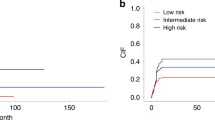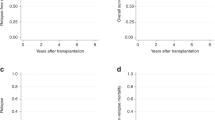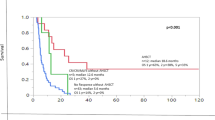Abstract
In 2008, a European registry of relapsed acute promyelocytic leukemia was established by the European LeukemiaNet. Outcome data were available for 155 patients treated with arsenic trioxide in first relapse. In hematological relapse (n=104), 91% of the patients entered complete hematological remission (CR), 7% had induction death and 2% resistance, 27% developed differentiation syndrome and 39% leukocytosis, whereas no death or side effects occurred in patients treated in molecular relapse (n=40). The rate of molecular (m)CR was 74% in hematological and 62% in molecular relapse (P=0.3). All patients with extramedullary relapse (n=11) entered clinical and mCR. After 3.2 years median follow-up, the 3-year overall survival (OS) and cumulative incidence of second relapse were 68% and 41% in hematological relapse, 66% and 48% in molecular relapse and 90 and 11% in extramedullary relapse, respectively. After allogeneic or autologous transplantation in second CR (n=93), the 3-year OS was 80% compared with 59% without transplantation (n=55) (P=0.03). Multivariable analysis demonstrated the favorable prognostic impact of first remission duration ⩾1.5 years, achievement of mCR and allogeneic or autologous transplantation on OS of patients alive after induction (P=0.03, P=0.01, P=0.01) and on leukemia-free survival (P=0.006, P<0.0001, P=0.003), respectively.
This is a preview of subscription content, access via your institution
Access options
Subscribe to this journal
Receive 12 print issues and online access
$259.00 per year
only $21.58 per issue
Buy this article
- Purchase on SpringerLink
- Instant access to full article PDF
Prices may be subject to local taxes which are calculated during checkout



Similar content being viewed by others
References
Wang ZY, Chen Z . Acute promyelocytic leukemia: from highly fatal to highly curable. Blood 2008; 111: 2505–2015.
Degos L, Dombret H, Chomienne C, Daniel MT, Micléa JM, Chastang C et al. All-trans-retinoic acid as a differentiating agent in the treatment of acute promyelocytic leukemia. Blood 1995; 85: 2643–2653.
Castagnola C, Lunghi M, Corso A, Tajana M, Zappasodi P, Dabusti M et al. Management of acute promyelocytic leukemia relapse in the ATRA era. Haematologica 1998; 83: 714–717.
Thomas X, Dombret H, Cordonnier C, Pigneux A, Gardin C, Guerci A et al. Treatment of relapsing acute promyelocytic leukemia by all-trans retinoic acid therapy followed by timed sequential chemotherapy and stem cell transplantation. Leukemia 2000; 14: 1006–1013.
Sanz MA, Labopin M, Gorin NC, de la Rubia J, Arcese W, Meloni G et al. Hemotopoietic stem cell transplantation for adults with acute promyelocytic leukemia in the ATRA era: a survey of the European Cooperative Group for Blood and Marrow Transplantation. Bone Marrow Transplant 2007; 39: 461–469.
Lengfelder E, Hofmann WK, Nowak D . Impact of arsenic trioxide in the treatment of acute promyelocytic leukemia. Leukemia 2012; 26: 433–442.
Soignet SL, Frankel SR, Douer D, Tallman MS, Kantarjian H, Calleja E et al. United States multicenter study of arsenic trioxide in relapsed acute promyelocytic leukemia. J Clin Oncol 2001; 19: 3852–3860.
Thomas X, Pigneux A, Raffoux E, Huguet F, Caillot D, Fenaux P . Superiority of an arsenic trioxide-based regimen over a historic control combining all-trans retinoic acid plus intensive chemotherapy in the treatment of relapsed acute promyelocytic leukemia. Haematologica 2006; 91: 996–997.
Sanz MA, Grimwade D, Tallman MS, Lowenberg B, Fenaux P, Estey EH et al. Management of acute promyelocytic leukemia: recommendations from an expert panel on behalf of the European LeukemiaNet. Blood 2009; 113: 1875–1891.
Meloni G, Diviero D, Vignetti M, Avvisati G, Capria S, Petti MC et al. Autologous bone marrow transplantation for acute promyelocytic leukemia in second remission: prognostic relevance of pretransplant minimal residual disease assessment by reverse transcription polymerase chain reaction of the PML/RARα fusion gene. Blood 1997; 90: 1321–1325.
Ramadan SM, Di Veroli A, Camboni A, Breccia M, Iori AP, Aversa F et al. Allogeneic stem cell transplantation for advanced acute promyelocytic leukemia in the ATRA and ATO era. Haematologica 2012; 97: 1731–1735.
Au WY, Lie AK, Chim CS, Liang R, Ma SK, Chan CH et al. Arsenic trioxide in comparison with chemotherapy and bone marrow transplantation for the treatment of relapsed acute promyelocytic leukaemia. Ann Oncol 2003; 14: 752–757.
Lou Y, Qian W, Meng H, Mai W, Tong H, Tong Y et al. High efficacy of arsenic trioxide plus all-trans retinoic acid based induction and maintenance therapy in newly diagnosed acute promyelocytic leukemia. Leuk Res 2013; 37: 37–42.
Grimwade D, Jovanovic JV, Hills RK, Nugent EA, Patel Y, Flora R et al. Prospective minimal residual disease monitoring to predict relapse of acute promyelocytic leukemia and to direct pre-emptive arsenic trioxide therapy. J Clin Oncol 2009; 27: 3650–3658.
Lo Coco F, De Santis S, Esposito A, Divona M, Diverio D . Molecular monitoring of hematologic malignancies: current and future issues. Semin Hematol 2002; 39: 14–17.
Esteve J, Escoda L, Martín G, Rubio V, Díaz-Mediavilla J, González M et al. Outcome of patients with acute promyelocytic leukemia failing to front-line treatment with all-trans retinoic acid and anthracycline-based chemotherapy (PETHEMA protocols LPA96 and LPA99): benefit of an early intervention. Leukemia 2007; 21: 446–452.
Sanz MA, Fenaux P, Lo Coco F, European APL Group of Experts. Arsenic trioxide in the treatment of acute promyelocytic leukemia. A review of current evidence. Haematologica 2005; 90: 1231–1235.
Cheson BD, Bennett JM, Kopecky KJ, Büchner T, Willman CL, Estey EH et al. Revised recommendations of the International Working Group for Diagnosis, Standardization of Response Criteria, Treatment Outcomes, and Reporting Standards for Therapeutic Trials in Acute Myeloid Leukemia. J Clin Oncol 2003; 21: 4642–4649.
van Dongen JJ, Macintyre EA, Gabert JA, Delabesse E, Rossi V, Saglio G et al. Standardized RT-PCR analysis of fusion gene transcripts from chromosome aberrations in acute leukemia for detection of minimal residual disease. Report of the BIOMED-1 Concerted Action: investigation of minimal residual disease in acute leukemia. Leukemia 1999; 13: 1901–1928.
Gabert J, Beillard E, van der Velden VH, Bi W, Grimwade D, Pallisgaard N et al. Standardization and quality control studies of 'real-time' quantitative reverse transcriptase polymerase chain reaction of fusion gene transcripts for residual disease detection in leukemia - a Europe Against Cancer program. Leukemia 2003; 17: 2318–2357.
Kaplan EL, Meier P . Non-parametric estimation from incomplete observation. J Am Stat Assoc 1958; 53: 457–481.
Cooley TA, Leisenring W, Crowley J, Storer BE . Estimation of failure. Probabilities in the presence of competing risks: new representation of old estimators. Stat Med 1999; 18: 695–706.
Gray R . A class of K-sample tests for comparing the cumulative incidence of a competing risk. Ann Stat 1988; 16: 1141–1151.
Cox D . Regression models and life tables. J R Stat Soc B 1972; 34: 187–220.
Pacilli L, Lo Coco F, Ramadan SM, Gianni L, Pingi A, Remotti D et al. Promyelocytic lymphoma of the spine: a case report and review of the literature. Adv Hematol 2010; 2010: 137608.
Lou Y, Suo S, Tong Y, Tong H, Qian W, Meng H et al. Outcomes and prognostic factors of first relapsed acute promyelocytic leukemia patients undergoing salvage therapy with intravenous arsenic trioxide and chemotherapy. Ann Hematol 2014; 93: 941–948.
Au WY, Tam S, Fong BM, Kwong YL . Elemental arsenic entered the cerebrospinal fluid during oral arsenic trioxide treatment of meningeal relapse of acute promyelocytic leukemia. Blood 2006; 107: 3012–3013.
De Botton S, Sanz MA, Chevret S, Dombret H, Martin G, Thomas X et al. Extramedullary relapse in acute promyelocytic leukemia treated with all-trans retinoic acid and chemotherapy. Leukemia 2006; 20: 5–41.
Montesinos P, Díaz-Mediavilla J, Debén G, Prates V, Tormo M, Rubio V et al. Central nervous system involvement at first relapse in patients with acute promyeolcytic leukemia treated with all-trans retinoic acid and anthracycline monochemotherapy without intrathecal prophylaxis. Haematologica 2009; 94: 1242–1249.
Wang H, Cao F, Li J, Li L, Li Y, Shi C et al. Arsenic trioxide and mannitol for the treatment of acute promyelocytioc leukemia relapse in central nervous system. Blood 2014; 124: 1998–2000.
Douer D, Hu W, Giralt S, Lill M, DiPersio J . Arsenic trioxide (trisenox) therapy for acute promyelocytic leukemia in the setting of hematopoietic stem cell transplantation. Oncologist 2003; 8: 132–140.
De Botton S, Fawaz A, Chevret S, Dombret H, Thomas X, Sanz M et al. Autologous and allogeneic stem-cell transplantation as salvage treatment of acute promyelocytic leukemia initially treated with all-trans-retinoic acid: a retrospective analysis of the European acute promyelocytic leukemia group. J Clin Oncol 2005; 23: 120–126.
Thirugnanam R, George B, Chendamarai E, Lakshmi KM, Balasubramanian P, Viswabandya A et al. Comparison of clinical outcomes of patients with relapsed acute promyelocytic leukemia induced with arsenic trioxide and consolidated with either an autologous stem cell transplant or an arsenic trioxide-based regimen. Biol Blood Marrow Transplant 2009; 15: 1479–1484.
Yanada M, Tsuzuki M, Fujita H, Fujimaki K, Fujisawa S, Sunami K et al. Phase 2 study of arsenic trioxide followed by autologous hematopoietic cell transplantation for relapsed acute promyelocytic leukemia. Blood 2013; 121: 3095–3102.
Pemmaraju N, Tanaka MF, Ravandi F, Lin H, Baladandayuthapani V, Rondon G et al. Outcomes in patients with relapsed or refractory acute promyelocytic leukemia treated with or without autologous or allogeneic hematopoietic stem cell transplantation. Clin Lymphoma Myeloma Leuk 2013; 13: 485–492.
Fujita H, Asou N, Iwanaga M, Hyo R, Nomura S, Kiyoi H et al. Role of hematopoietic stem cell transplantation for relapsed acute promyelocytic leukemia: a retrospective analysis of JALSG-APL97. Cancer Sci 2013; 104: 1339–1345.
Holter Chakrabarty JL, Rubinger M, Le-Rademacher J, Wang HL, Grigg A, Selby GB et al. Autologous is superior to allogeneic hematopoietic cell transplantation for acute promyelocytic leukemia in second complete remission. Biol Blood Marrow Transplant 2014; 20: 1021–1025.
Kohno A, Morishita Y, Iida H, Yanada M, Uchida T, Hamaguchi M et al. Hematopoietic stem cell transplantation for acute promyelocytic leukemia in second or third complete remission: a retrospective analysis in the Nagoya Blood and Marrow Transplantation Group. Int J Hematol 2008; 87: 210–216.
Lo-Coco F, Avvisati G, Vignetti M, Thiede C, Orlando SM, Iacobelli S et al. Retinoic acid and arsenic trioxide for acute promyelocytic leukemia. N Engl J Med 2013; 369: 111–121.
Fenaux P, Chevret S, Guerci A, Fegueux N, Dombret H, Thomas X et al. Long-term follow-up confirms the benefit of all-trans retinoic acid in acute promyelocytic leukemia. European APL group. Leukemia 2000; 14: 1371–1377.
Acknowledgements
The online registry for data collection was supported by the companies CEPHALON and TEVA.
Author information
Authors and Affiliations
Consortia
Corresponding author
Ethics declarations
Competing interests
Eva Lengfelder and David Grimwade received research support from CEPHALON and TEVA. Francesco Lo-Coco and Maria Pagoni participated in speaker’s bureau of TEVA. The other authors declare no conflict of interest.
Rights and permissions
About this article
Cite this article
Lengfelder, E., Lo-Coco, F., Ades, L. et al. Arsenic trioxide-based therapy of relapsed acute promyelocytic leukemia: registry results from the European LeukemiaNet. Leukemia 29, 1084–1091 (2015). https://doi.org/10.1038/leu.2015.12
Received:
Revised:
Accepted:
Published:
Issue date:
DOI: https://doi.org/10.1038/leu.2015.12
This article is cited by
-
Clinical Indicators of Hepatotoxicity in Newly Diagnosed Acute Promyelocytic Leukemia Patients Undergoing Arsenic Trioxide Treatment
Biological Trace Element Research (2024)
-
Autologous hematopoietic cell transplantation during second or subsequent complete remission of acute promyelocytic leukemia: a prognostic factor analysis
Bone Marrow Transplantation (2022)
-
Treatment for relapsed acute promyelocytic leukemia
Annals of Hematology (2022)
-
Hematopoietic stem cell transplantation for adults with relapsed acute promyelocytic leukemia in second complete remission
Bone Marrow Transplantation (2021)
-
Autologous hematopoietic cell transplantation for acute myeloid leukemia in adults: 25 years of experience in Japan
International Journal of Hematology (2020)



